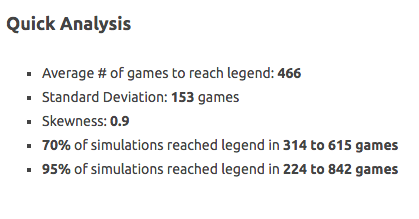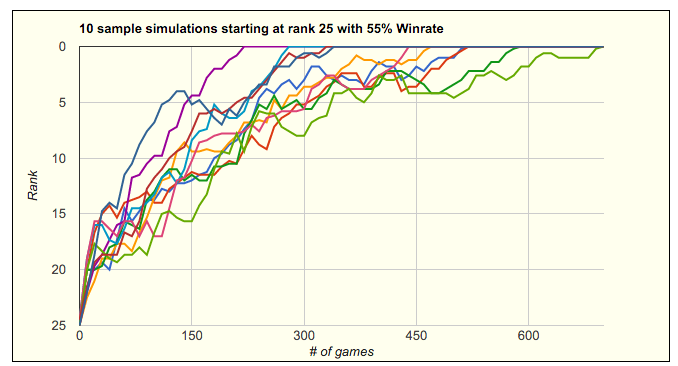How long does it take to achieve the legendary rank in Hearthstone? This handy simulator will answer to this question and show how long it will take to reach legendary depending on your win rate and your current rank.
How does it work? Just enter your rank and your win rate and hit calculate. Depending on your machine it might take a couple of seconds for the simulator to run. You can adjust the maximum number of games to simulate to fine-tune the results.
A detailed explanation of the features is given below.
Probability of reaching legend in Hearthstone
Golden areas show confidence intervals. Light is the 70% and dark is the 95% confidence interval. Your results will fall into those areas in 70%, respectively 95% of all cases.
Ten random simulated samples
How does the Hearthstone Legendary Simulator work?
Once you hit calculate the simulator runs 10,000 simulations of a player with the given win rate and starting at the given rank and with the given bonus stars. Each simulation runs until it hits legendary or the maximum number of games is reached (1,000 by default).
Among other data, the simulator determines the average number of games it takes to reach legendary, standard deviation, and confidence intervals.
Please note that the simulator only simulates (ldo) and while 10,000 runs are quite a lot, the numbers will fluctuate a tiny bit when hitting the calculate multiple times. For win rates below 55%, you need to adjust the maximum number of games and maybe also the number of simulations,
but exercise some caution – numbers too big might crash the script.
What does the simulator show?
Quick Analysis

Average # of games: The arithmetic mean of the number of games of all simulations until they reached legendary rank.
Standard Deviation: Average deviation of the distribution from the mean – » Wikipedia: Standard Deviation
Skewness: Third standardized moment of the distribution. A number close to 0 means a rather symmetrical distribution around the mean, positive numbers indicate a tilt (or skew) to the right. The lower the win rate, the bigger the skew of
the distribution. » Wikipedia: Skewness
70% / 95%: If you remove the results of 30% of all simulations (the top 15% and the bottom 15%) this interval shows how many games you’ll probably (in 70% of all cases) need to play to reach legend. The 95% interval is a bit wider, removing only the top 2.5% and the bottom 2.5% outliers. It’s 1 in 20 that you’ll need more games to reach legend or accomplish this feat in fewer games.
Chart 1: Probability to reach legend

This chart shows the distribution of all simulations. The number of games to reach legendary are on the x-axis, and the probability is on the y-axis. Note the golden areas – those are the 70% and 95% confidence intervals. Meaning: in 95% of all simulations the player reached legend somewhere in the light golden area and in 70% of all simulations he reached legendary in the dark golden strip.
Chart 3: Random Samples

This chart shows 10 (out of 10,000) simulations and how the simulated Hearthstone players climbed over time to reach legend.
Simulation Details
This table shows ten percentiles of all simulations – the top 10% that reached legend the quickest, the next 10%, and so on until the slowest. This gives some more numbers to the variance that can occur. Those simulations were all done with the same
win rate for each game, yet in the example on the right, the top 10% only needed one-third of the number of games the bottom 10% needed.
Those top 10% were not better in any way, they just were much luckier than the bottom 10%. Well, that’s eSports (or anything that has random elements in it).
Losing Streaks
Very simple: Shows the probability of losing the next X Hearthstone games in a row with the given win rate.
While those numbers might seem small, don’t underestimate their significance over many games. Playing 100 games you’re almost guaranteed to lose at least 4 or 5 games in a row at least once.
Climbing Ranks in Hearthstone
The simulator abides by the rules of Hearthstone. No stars are lost for losses on rank floors and whenever three games are won in a row the player gets a win streak star (part of a rank). Those bonus stars
only apply until rank 5 in Diamond league. Bonus Stars for finishing the last season particularly well are also taken into consideration.

